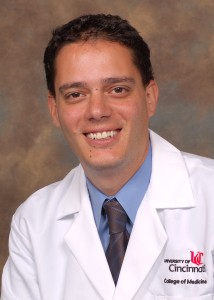Investigation of a Novel Mediator of Cardiac Hypertrophy Funded by $1.7 Million Grant
Determining how the protein human antigen R (HuR) is activated, its function after activation, and possible association with cardiac hypertrophy are the goals of a study funded by a $1.7 million National Institute of Health (NIH) five-year grant recently awarded to Michael Tranter, PhD, and principal investigator for the study. Initial findings show that the protein appears to mediate the development of cardiac hypertrophy, Dr. Tranter says.
Dr. Tranter and Jack Rubinstein, MD, co-investigator, are both assistant professors of medicine, University of Cincinnati College of Medicine’s department of internal medicine, division of cardiovascular health and disease. Dr. Rubinstein elaborates on the potential significance of studying HuR. “In persons with hypertension, development of left ventricular hypertrophy may result in less efficient cardiac pumping and heart failure. As people are living longer, these cardiac conditions are becoming increasing problems, especially since there are no good therapies to reverse hypertrophy associated heart failure.” Dr. Rubinstein and Dr. Tranter both caution that clinical application is some years in the future. However, it is possible, according to Dr. Tranter, that “if we prevent HuR activation, we may be able eventually to inhibit the progression of left ventricular hypertrophy, which is the precursor to heart failure with preserved ejection fraction.”
Human antigen R is a member of a class of RNA-binding proteins. Dr. Tranter explains that although it is expressed in many cell types, including cardiomyocytes, HuR’s role in cardiac physiology has not been well studied.1 “To investigate the functional role of HuR protein activity in the heart, we created a new mouse model in which genetic deletion of HuR can be induced specifically in the cardiac myocytes, and we have used these mice to show that deletion of HuR in the myocytes protects against the development of pathological hypertrophy following pressure overload,” says Dr. Tranter. In this preliminary work,1 although cardiac-specific HuR deletion in mice did not exhibit an overt basal phenotype, they demonstrated preserved ejection fraction and reduced ventricular remodeling in comparison with wild-type littermates at eight weeks after post-transverse aortic constriction.
The first aim of the NIH study is to learn the functional role of HuR in the development and progression of pathological hypertrophy and identify the downstream targets of HuR in hypertrophic myocytes. Secondly, says Dr. Tranter, “we will also determine the upstream mechanisms by which HuR is activated in the hypertrophic heart and identify HuR as a novel mediator of Gq-dependent pathological hypertrophy. This work is clinically significant in that we will find out whether direct inhibition of HuR has translational value as a therapeutic target for the prevention or treatment of pathological hypertrophy.”
Reference
1. Tranter M, Kraynik S, Anthony SR, Slone S, Nieman ML, John LN, Rubinstein J. Cardiac-specific deletion of HuR reduces pathological hypertrophy and ventricular remodeling following transverse aortic constriction. Circ Res. 2015;117:A60.
Suggested Reading
Slone S, Anthony SR, Wu X, Benoit JB, Aube J, Xu L, Tranter M. Activation of HuR downstream of p38 MAPK promotes cardiomyocyte hypertrophy. Cell Signal. 2016;28:1735-1741.
Michael Tranter, PhD
Assistant Professor of Medicine
Phone: (513) 558-2356
Email: trantemc@ucmail.uc.edu
Jack Rubinstein, MD
Assistant Professor of Medicine
Phone: (513) 558-3062
Email: jack.rubinstein@uc.edu
Connect with Dr. Rubinstein on Doximity
Leave a reply →


